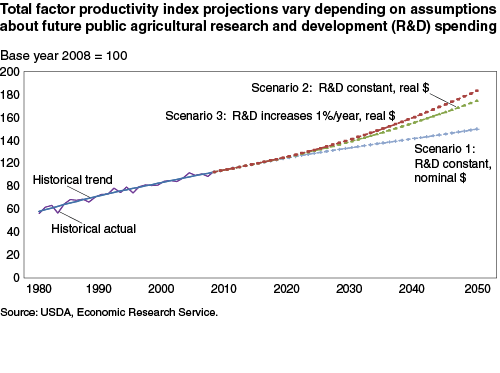Public Agricultural Research Investment Helps Determine Productivity Growth
- by Paul Heisey, Sun Ling Wang and Keith Fuglie
- 3/1/2012
Nearly all U.S. growth in agricultural output has come from increased productivity. Between 1948 and 2009, U.S. agricultural output rose 170 percent, but the aggregate of total inputs used in agriculture, such as land, labor, capital, and intermediate inputs like seed and fertilizer, has remained essentially unchanged. Rising output from existing inputs implies growth in agricultural productivity, which was 152 percent higher in 2009 than in 1948. The main driver of agricultural productivity growth is the application of new technologies to farming. Robust productivity growth has allowed U.S. agriculture to hold down the cost and environmental consequences of growing more food and fiber.
Statistical models have found a strong relationship between public agricultural research and development (R&D) spending and agricultural productivity growth. Investments in productivity-oriented research at public institutions affect productivity growth with a time lag, but the impacts persist for decades. Public agricultural R&D complements other factors, such as agricultural extension, farmer education, rural infrastructure, and private agricultural R&D, that contribute to agricultural productivity growth. However, productivity-oriented public agricultural research expenditures-excluding R&D on post-harvest, environmental, and rural development issues-have been declining since the mid-1990s (after adjusting for inflation).
Continued growth in U.S. agricultural productivity may depend critically on public investments in agricultural research. ERS researchers used statistical models to simulate future agricultural productivity growth based on three possible scenarios for public agricultural R&D expenditures.
- Scenario 1: Public research spending remains constant in today's (nominal) dollars and therefore declines in real (inflation-adjusted) terms.
- Scenario 2: Public research spending remains constant in real terms, implying an annual increase in nominal expenditures of 3.7 percent to offset anticipated future inflation in research costs.
- Scenario 3: Annual public research spending increases by 1 percent above the rate of inflation, or by 4.7 percent per year in nominal dollars.
With declining real R&D spending (scenario 1), the rate of agricultural productivity growth would fall before leveling off about 2035 at roughly 0.75 percent per year, about half its historical growth rate over the past 50 years. If current levels of resource use remain unchanged, U.S. agricultural output would rise 41 percent by 2050, about the same as projected U.S. population growth. Under constant real R&D (scenario 2), productivity growth would eventually stabilize at about 1.4 percent annually, and by 2050 output would increase 70 percent. With higher real R&D spending (scenario 3), productivity growth would accelerate before leveling off at about 1.6 percent per year. Total U.S. agricultural output would increase by 80 percent between 2010 and 2050, or about the same as the projected growth in global food demand.
This article is drawn from:
- Heisey, P., Wang, S.L. & Fuglie, K. (2011). Public Agriculture Research Spending and Future U.S. Agricultural Productivity Growth: Scenarios for 2010-2050. U.S. Department of Agriculture, Economic Research Service. EB-17.


